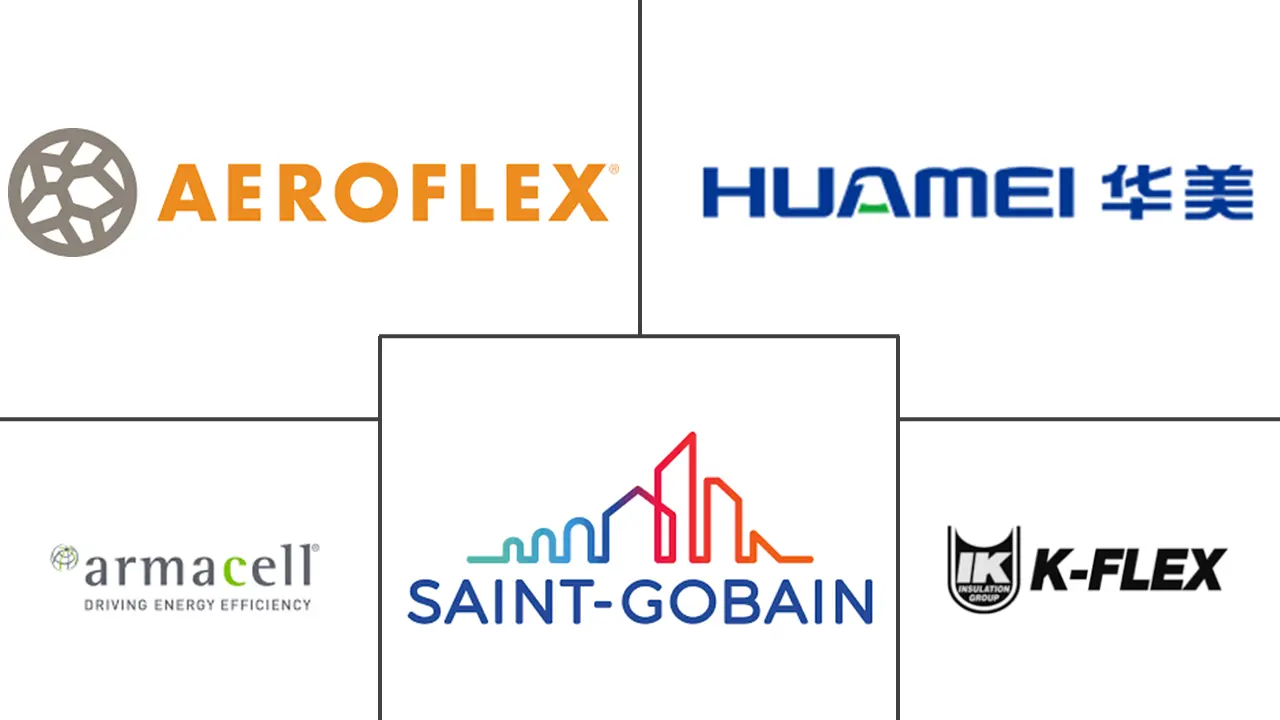Flexible Elastomeric Foam Market Size and Share
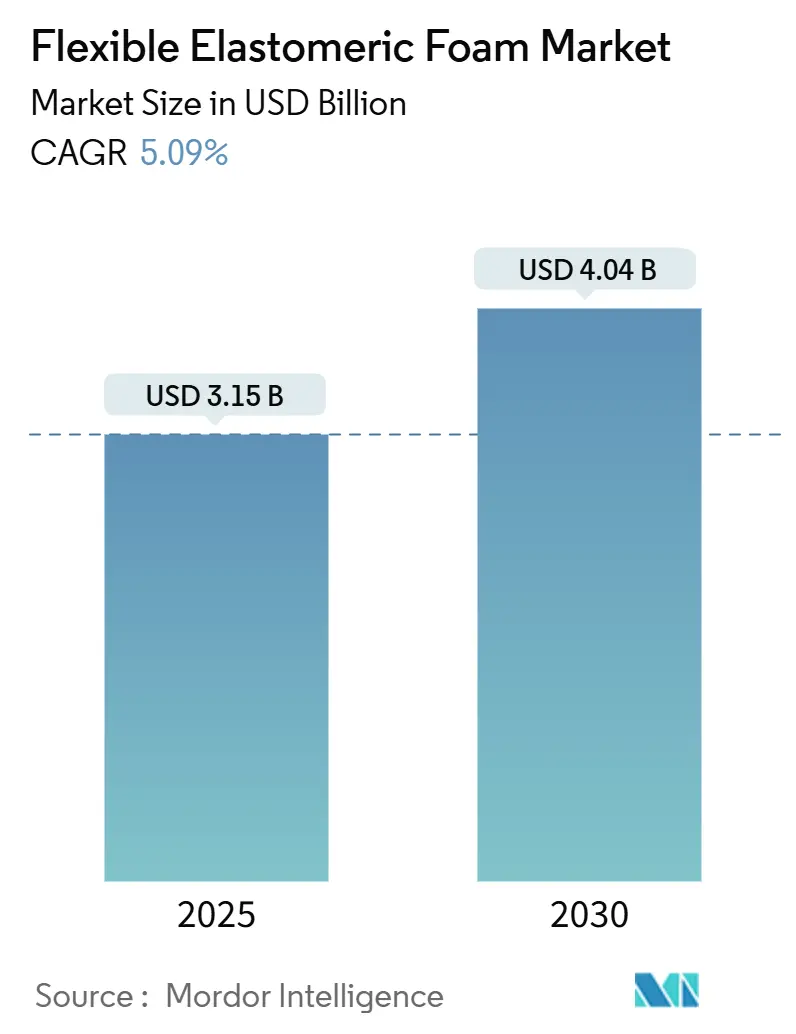
Flexible Elastomeric Foam Market Analysis by Mordor Intelligence
The flexible elastomeric foam market stood at USD 3.15 billion in 2025 and is forecast to reach USD 4.04 billion by 2030, advancing at a 5.09% CAGR. This trajectory reflects the material’s pivotal role in curbing thermal losses across HVAC, refrigeration, electric-vehicle battery packs and solar installations, all of which face tougher efficiency codes and higher operating temperatures. Near-term demand stems from Asia-Pacific’s rapid urban build-out, while medium-term momentum comes from worldwide F-gas phase-downs that nudge users toward high-performance insulation. Longer-term upside is anchored in electric-vehicle lightweighting, where the foam offers both heat control and weight savings. Competitive intensity is rising as multinational producers buy regional specialists to broaden portfolios, hedge raw-material cost swings and deepen formulation know-how. Across end markets, thermal applications keep expanding, yet acoustic use cases are gaining share as factories and data centers seek quieter interiors.
Key Report Takeaways
- By function, thermal insulation led with 75.19% of the flexible elastomeric foam market share in 2024, and is forecast to post the fastest 5.20% CAGR through 2030.
- By type, NBR/PVC commanded 54.04% revenue share in 2024, while EPDM is projected to register the highest 6.18% CAGR to 2030.
- By application, HVAC accounted for 43.18% of the flexible elastomeric foam market size in 2024, whereas solar installations are set to expand at a 6.75% CAGR.
- By region, Asia-Pacific dominated with a 45.18% flexible elastomeric foam market share in 2024 and is expected to grow at 7.02% CAGR through 2030.
Global Flexible Elastomeric Foam Market Trends and Insights
Driver Impact Analysis
| Driver | (~) % Impact on CAGR Forecast | Geographic Relevance | Impact Timeline |
|---|---|---|---|
| Increase Demand in HVAC and Refrigeration Systems | +1.8% | Global, strongest in Asia-Pacific | Medium term (2-4 years) |
| Mandatory F-Gas phase-down | +1.2% | North America & EU, expanding globally | Long term (≥ 4 years) |
| Automotive lightweighting for EV range extension | +0.9% | Global, led by China and North America | Medium term (2-4 years) |
| Growing Demand for Energy Efficiency | +1.1% | Global | Long term (≥ 4 years) |
| Increasing Advances in Manufacturing Technology | +0.6% | Developed markets, expanding to Asia-Pacific | Short term (≤ 2 years) |
| Source: Mordor Intelligence | |||
Increase Demand In HVAC And Refrigeration Systems
Rapid urbanization and rising disposable incomes in India, Southeast Asia, and China accelerate HVAC installations, driving large volumes of insulation. India’s HVAC sector targets USD 30 billion in revenue by 2030 at a 15.8% CAGR, spurred by “Make in India” incentives that localize component production. As multistory offices, malls, and data centers proliferate, condensation control and tighter temperature tolerances lift the specification rate of closed-cell foam. Variable-refrigerant-flow technology and IoT-enabled chillers magnify heat-flux variability, making elastomeric foam’s low thermal conductivity vital for consistent equipment efficiency. Commercial retrofits expand demand because energy-code updates oblige older buildings to upgrade duct and pipe insulation.
Mandatory F-Gas Phase-Down
The European Union’s tighter F-gas rules, effective January 2025, require lower-GWP refrigerants, bulk HFC quotas, and granular leak-reporting standards, indirectly favoring non-refrigerant measures such as high-grade foam insulation[1]European Commission, “Regulation (EU) 2024/573 on Fluorinated Greenhouse Gases,” ec.europa.eu. In the United States, the EPA’s mandate to trim HFC consumption by 85% by 2029 redirects spending toward passive thermal solutions in new supermarkets and cold-storage facilities[2]U.S. Environmental Protection Agency, “Phasedown of Hydrofluorocarbons (HFCs),” epa.gov. Variable-refrigerant-flow systems enjoy a grace period until 2027, giving foam vendors a multiyear window to displace legacy fiber wraps. The net effect is a higher demand for materials that lock in system efficiency independent of refrigerant choice, repositioning elastomeric foam from optional to essential.
Automotive Lightweighting For EV Range Extension
Battery-electric vehicles gain range when curb weight falls, turning every non-structural component into a target for mass reduction. Rogers Corporation’s silicone-based foam pads manage thermal propagation and vibration under cyclic loads while weighing far less than metallic shields. OEMs exploit closed-cell foam in battery trays, HVAC lines and cabin-quieting panels, merging thermal and acoustic functions in one part. Integration with phase-change materials curbs peak temperature spikes during rapid charging, reinforcing safety and lifespan benefits. China and North America lead adoption because of aggressive EV penetration targets, but European brands quickly follow to comply with fleet CO₂ limits.
Growing Demand For Energy Efficiency
Building envelopes account for a sizable slice of global energy use, prompting governments to tighten thermal-transmittance limits. Studies show advanced foams with λ values near 0.07 W/m·K can cut annual roof energy use by 35-45% and wall loads by 15%. Incentives such as tax credits and green-loan programs in the United States and parts of Asia reward owners for installing higher R-value materials. Combining foam with phase-change inclusions creates “thermal batteries” that smooth indoor temperature swings, thereby shrinking HVAC runtimes in schools, hospitals, and logistics centers.
Restraint Impact Analysis
| Restraint | (~) % Impact on CAGR Forecast | Geographic Relevance | Impact Timeline |
|---|---|---|---|
| High butadiene & neoprene price volatility | -0.8% | Global, particularly Asia-Pacific | Short term (≤ 2 years) |
| Fire-code stringency vs. halogenated additives | -0.6% | North America & EU, expanding globally | Medium term (2-4 years) |
| VOC emission scrutiny in indoor environments | -0.4% | Developed markets, expanding globally | Long term (≥ 4 years) |
| Source: Mordor Intelligence | |||
High Butadiene & Neoprene Price Volatility
Synthetic-rubber feedstocks track oil and naphtha swings, exposing foam producers to sudden cost spikes. Spot butadiene prices in Asia saw multiple increments across 2024, prompting suppliers to issue surcharges that squeezed converter margins. Concentrated regional production and logistics bottlenecks amplify risk, while limited drop-in substitutes force manufacturers either to absorb costs or raise list prices, possibly dampening short-cycle orders. Hedging strategies offer partial relief but cannot cover structural shortages if crackers experience unplanned shutdowns.
Fire-Code Stringency Vs. Halogenated Additives
Updated North American and European building codes tighten flame-spread and smoke-developed indices for interior linings, yet regulators simultaneously restrict brominated and chlorinated flame retardants on toxicity grounds. Polyurethane-foam lobby groups note that most foams remain “combustible” under code definitions and therefore need extra barriers or special listing when used in occupied spaces[3]American Chemistry Council, “Polyurethane Foam and Building Codes,” americanchemistry.com . The hunt for halogen-free systems raises formulation costs and prolongs product-development cycles. Some customers postpone upgrades until local authorities finalize acceptance criteria, delaying revenue recognition for newer foam grades.
Segment Analysis
By Function: Thermal Dominance Drives Market Leadership
Flexible elastomeric foam’s primary purpose remains thermal insulation, a segment that supplied 75.19% of global revenue and mirrored the broader flexible elastomeric foam market CAGR at 5.20% through 2030. In 2024, thermal products accounted for 75.19% of the flexible elastomeric foam market size, cementing their status as the anchor profit pool. HVAC duct liners, refrigeration suction lines and process-chiller jackets use the material to limit heat gain, curb condensation and prevent vapor-drive. Growth is supported by climate-control upgrades in aging commercial properties and an uptick in cold-chain warehousing linked to e-commerce groceries. Industrial players are layering in acoustic dampening particles and phase-change microcapsules, creating dual-purpose foams that cushion sound without sacrificing R-value. These hybrids win share in data centers and high-rise mechanical rooms where both noise and thermal tolerance are critical.
Acoustic insulation remains smaller but strategically significant. Airlines, shipyards and luxury auto makers specify closed-cell elastomers to block vibration-transmitted sound in tight cavities where mineral wool cannot fit. Although acoustic-only demand trails thermal by volume, cross-over grades command premium pricing that lifts gross margins for producers. Future policy pressure for quieter urban environments underlines the segment’s relevance, positioning it as a long-term companion to the dominant thermal line.
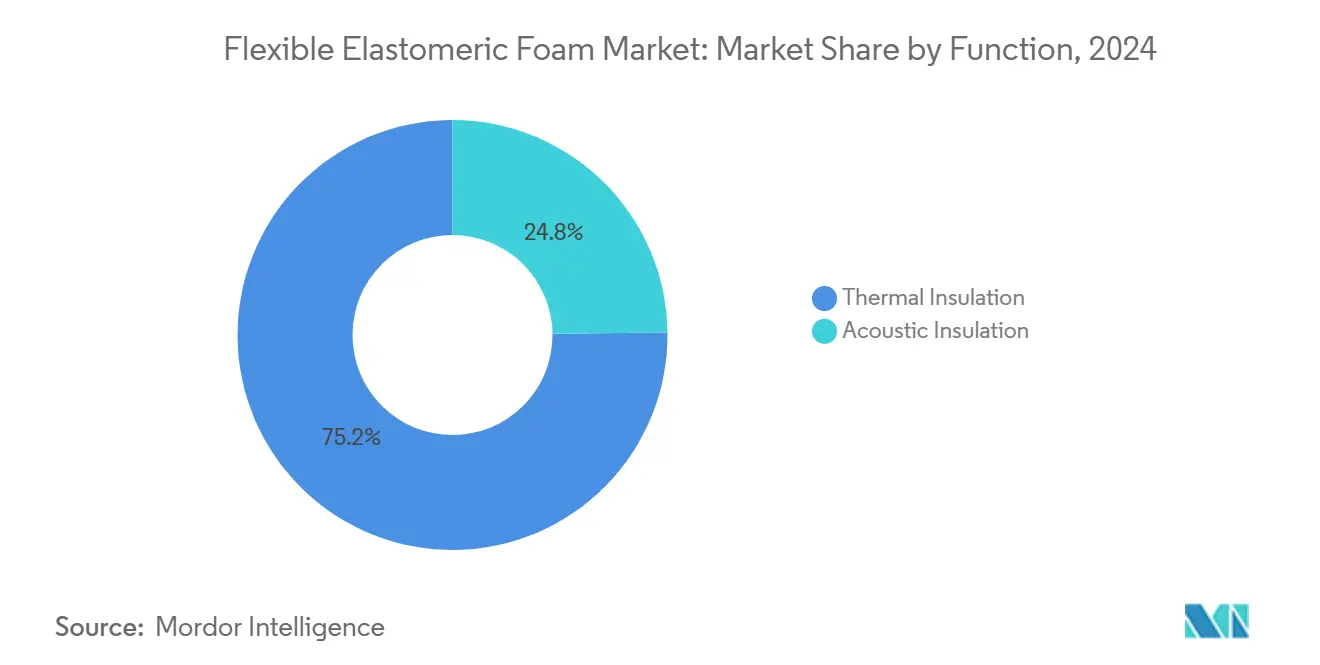
Note: Segment Share of all individual segments available upon report purchase
By Type: NBR/PVC Leadership Faces EPDM Challenge
NBR/PVC blends delivered 54.04% of global sales in 2024, reflecting decades of qualification in chilled-water pipes, duct liners and process equipment. The blend’s oil resistance, moderate cost and installer familiarity keep it entrenched across retrofit jobs. It captured 54.04% share of the flexible elastomeric foam market size in 2024. Suppliers tweak plasticizer loads and cell morphology to hit divergent density, flexibility and temperature thresholds demanded by chemical plants versus office-building contractors.
EPDM, by contrast, is winning specifications at a 6.18% CAGR thanks to superior UV resistance, broad operating-temperature windows and low fogging—attributes prized in EV battery enclosures and rooftop solar rails. OEMs in China and the United States pivot to EPDM-based sheets for battery gasketing because the polymer retains resilience across thousands of charge cycles.. Research on modified silica fume in EPDM matrices confirms mechanical-strength gains alongside lower thermal-conductivity values. Natural-rubber and chloroprene niches persist in medical devices and marine hatch seals, but their share is expected to erode slowly unless sustain-ability credentials or unique regulatory approvals favor retention.
By Application: HVAC Dominance Meets Solar Surge
HVAC projects represented 43.18% of 2024 turnover, underscoring the sector’s importance to the flexible elastomeric foam market. Central-plant upgrades, district-cooling loops and smarter thermostats push owners to minimize distribution losses, steering them toward closed-cell insulation for chilled-water reticulation. The automotive cohort remains robust as OEMs integrate foam inside battery trays, thermal gaps and cabin panels to offset the mass of traction batteries. In revenue terms, HVAC captured 43.18% of the flexible elastomeric foam market share in 2024, while automotive is expanding briskly on an EV backlog that extends into late 2026.
Solar installations post the fastest 6.75% CAGR. Modules face performance drops when cells exceed 60 °C; integrating low-conductivity foam behind panels retains output longer and counters daily thermal cycling. Peer-reviewed work on phase-change-foam composites shows cell-temperature reductions of 10 °C, translating into notable watt-hour gains over a 25-year asset life. Refrigeration, medical devices and bespoke industrial systems round out the mix, giving suppliers a diversified end-use matrix that buffers cyclical swings in any single vertical.
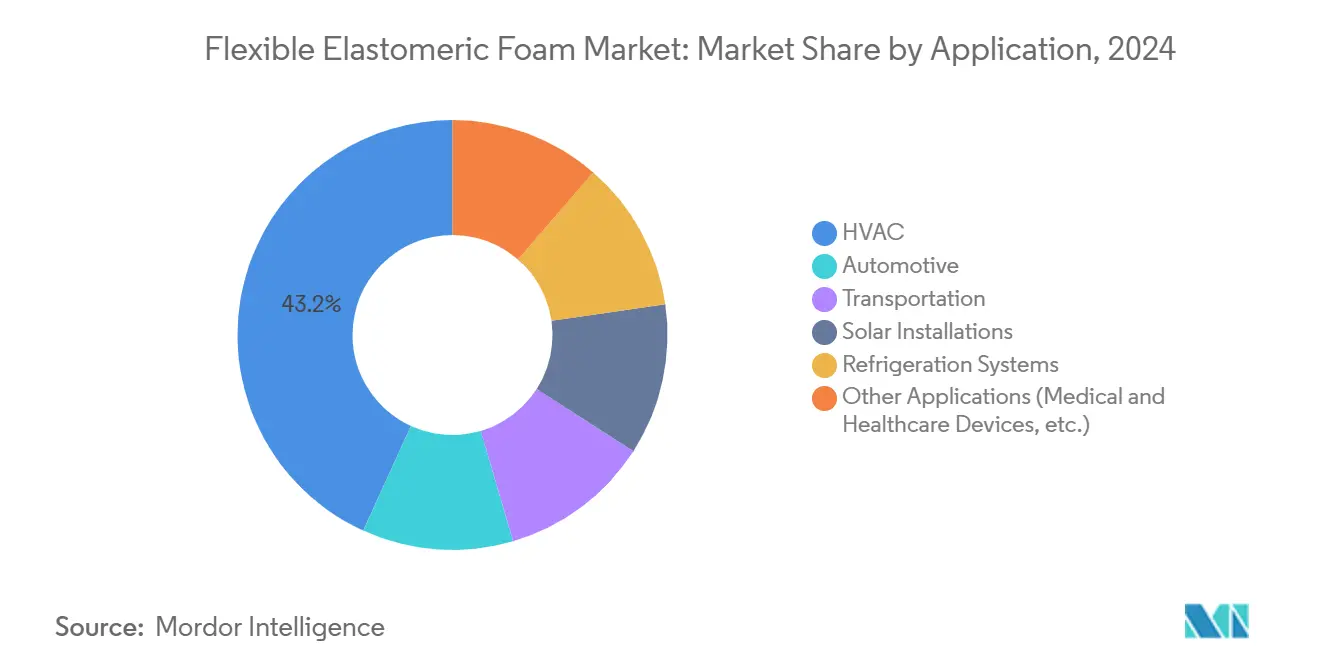
Note: Segment Share of all individual segments available upon report purchase
Geography Analysis
Asia-Pacific held 45.18% of 2024 global sales and is projected to expand at 7.02% CAGR through 2030, outpacing all other regions. China’s infrastructure spending and India’s USD 30 billion HVAC roadmap underpin volume growth, while Japanese and South Korean producers drive process innovations that lower scrap and energy use. The region’s governments embed insulation-performance thresholds into newer building codes, amplifying baseline demand. Local converters benefit from proximity to petrochemical feedstocks, enabling cost advantages over European and North American peers.
North America is a steady, regulation-led buyer. City-level energy codes, federal tax incentives and the EPA’s HFC drawdown sustain upgrade cycles in offices, schools and data centers. Automakers in Michigan, Tennessee, Ontario and Nuevo León are the early adopters of EPDM-based foam for battery packs, leveraging local raw-material supply chains and integrated testing labs. Growing cross-border trade under USMCA enhances Mexico’s appeal as an export base for cut-parts shipped into the United States.
Europe remains regulation-centric, propelled by the European Green Deal, which targets a 55% greenhouse-gas cut by 2030. F-gas quotas enforce refrigerant substitution, indirectly lifting insulation thickness in cold stores and supermarket display cases. Germany, France and Italy see incremental gains from factory retrofits and the rollout of heat pumps that require frost-proof insulation. Niche opportunities also emerge in offshore wind substations and hydrogen electrolyzer skids, where thermal control ensures electrolytic efficiency.
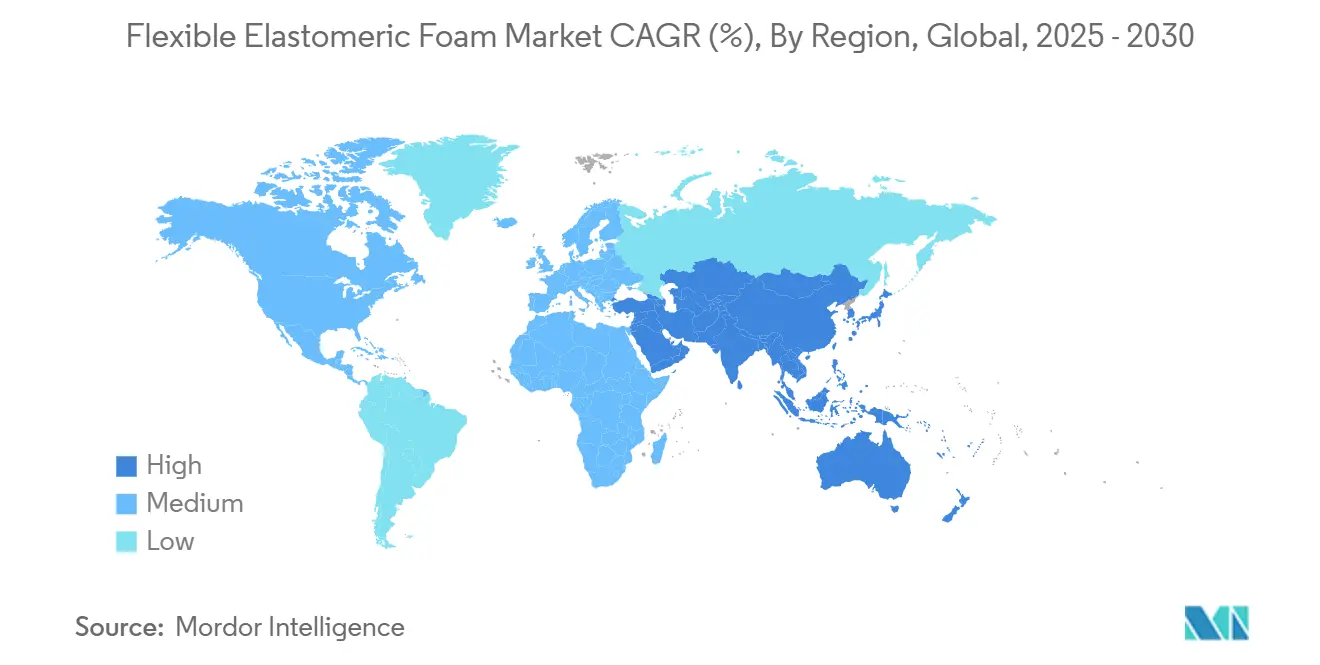
Competitive Landscape
Armacell, Saint Gobin, and Huamei Energy-Saving Technology Group dominate the global supply, with regional players like Sekisui, Zotefoams, and other contributing to a moderately concentrated market. Multinationals leverage brand equity, fire-test certifications, and global logistics while employing proprietary technologies to create substitution barriers. Mergers and acquisitions remain the primary strategy for market share expansion, complemented by investments in automation, such as Armacell’s ArmaGel XGC and ArmaFlex Ultima, which enhance efficiency and meet air-quality standards. Patent activity focuses on supercritical foaming, intumescent fillers, and bio-based EPDM blends. Competitive differentiation relies on technical-service teams, digital tools for insulation calculations, and rapid color matching. Raw material integration and dual-sourcing strategies protect margins and reduce supply chain risks.
Flexible Elastomeric Foam Industry Leaders
-
Saint-Gobain
-
L’Isolante K-FLEX S.p.A.
-
Huamei Energy-saving Technology Group Co., Ltd.
-
Aeroflex USA, Inc.
-
Armacell International S.A.
- *Disclaimer: Major Players sorted in no particular order
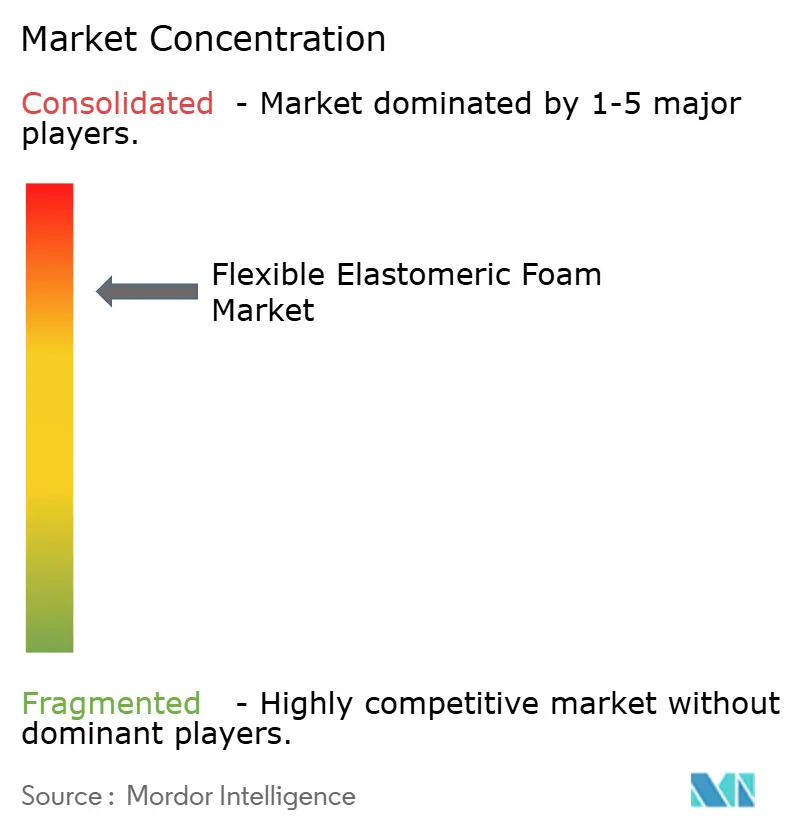


Recent Industry Developments
- April 2025: Armacell introduced ArmaGel XGC - a revolutionary, flexible elastomeric foam product that sets a new industry standard by combining superior insulation efficiency with improved worker safety through proprietary low-dust technology.
- March 2025: In North America, Armacell launched ArmaFlex Ultima, its premier plenum-rated insulation. This ultra-low smoke density insulation, powered by the company's patented ArmaPrene technology, redefines fire safety and performance benchmarks for flexible closed-cell elastomeric insulation.
Research Methodology Framework and Report Scope
Market Definitions and Key Coverage
Our study views the flexible elastomeric foam market as all closed-cell synthetic rubber insulation sold in tubes, sheets, or rolls that meet typical HVAC and refrigeration specifications for low thermal conductivity, high vapor diffusion resistance, and sustained flexibility. Materials in scope include NBR/PVC blends, EPDM, natural rubber, and chloroprene compounds that are factory produced and distributed through OEM or aftermarket channels worldwide.
Scope exclusions include rigid elastomeric blocks, spray polyurethane or phenolic foams, and general-purpose flexible polyurethane cushioning, which are not counted.
Segmentation Overview
- By Function
- Thermal Insulation
- Acoustic Insulation
- By Type
- Natural Rubber / Latex
- Nitrile Butadiene Rubber / Polyvinyl Chloride
- Ethylene Propylene Dine Monomer
- Chloroprene
- Other Types (ECO, SBR, etc.)
- By Application
- HVAC
- Automotive
- Transportation
- Solar Installations
- Refrigeration Systems
- Other Applications (Medical and Healthcare Devices, etc.)
- By Geography
- Asia-Pacific
- China
- India
- Japan
- South Korea
- Rest of Asia-Pacific
- North America
- United States
- Canada
- Mexico
- Europe
- Germany
- United Kingdom
- France
- Italy
- Rest of Europe
- South America
- Brazil
- Argentina
- Rest of South America
- Middle East and Africa
- Saudi Arabia
- South Africa
- Rest of Middle East and Africa
- Asia-Pacific
Detailed Research Methodology and Data Validation
Primary Research
Mordor analysts held structured calls with insulation distributors, HVAC OEM sourcing managers, and plant engineers across Asia-Pacific, North America, Europe, and the Gulf. The conversations clarified average selling prices, grade mix shifts, and installation loss factors, letting us fine-tune assumptions gathered from desk study and spot regional anomalies.
Desk Research
We started with trade and production datasets such as UN Comtrade tube rubber codes, Eurostat PRODCOM elastomeric sheet output, the US Census Current Industrial Reports, and AHRI quarterly HVAC equipment shipments. Standards and energy efficiency rules from ASHRAE, the European F-Gas Regulation, and India's Bureau of Energy Efficiency helped us size regulatory pull. Company financials from D&B Hoovers, news flows on capacity additions from Dow Jones Factiva, and white papers from the International Copper Association rounded out demand indicators. These examples are illustrative; many other public and subscription sources informed our desk work.
Market-Sizing & Forecasting
A top-down build linked global HVAC and refrigeration equipment production, regional building floor space starts, automotive HVAC fitment rates, butadiene cost trends, and policy adoption scores to estimate the insulation demand pool, which is then cross-checked through sampled ASP × volume roll-ups. Bottom-up gaps, where distributor data were thin, were bridged using channel checks and import parity adjustments. Multivariate regression, tested for autocorrelation and seasonality, projects each driver through 2030. Scenarios are pressure tested with experts before finalizing the CAGR.
Data Validation & Update Cycle
Outputs pass a two-analyst variance check, followed by senior review that benchmarks against independent shipment tallies and price indices. Models refresh yearly, and we trigger mid-cycle updates if feedstock shocks or policy shifts move the baseline materially.
Why Mordor's Flexible Elastomeric Foam Baseline Earns Trust
Published numbers differ because providers pick dissimilar product baskets, currency bases, and refresh cadences. Some tally rigid and spray foams or bolt on broader polymer families, while others lift historic sales without re-rating for today's ASP drift.
Key gap drivers include (i) material scope that stretches into flexible polyurethane, inflating totals; (ii) single-region surveys projected globally; (iii) inconsistent FX conversion years; and (iv) static price decks that ignore volatile butadiene swings. By anchoring scope strictly to closed-cell rubber insulation and refreshing prices every six months, Mordor avoids these pitfalls.
Benchmark comparison
| Market Size | Anonymized source | Primary gap driver |
|---|---|---|
| USD 3.15 B (2025) | Mordor Intelligence | - |
| USD 2.80 B (2024) | Global Consultancy A | Excludes aftermarket retrofit volumes |
| USD 10.65 B (2024) | Industry Association B | Includes flexible polyurethane and other foams |
| USD 3.62 B (2024) | Trade Journal C | Uses unverified average price escalation |
Taken together, the comparison shows that Mordor's disciplined scope control, live pricing checks, and blended top-down and bottom-up modeling give decision-makers a balanced, transparent starting point they can trace back to real variables and repeatable steps.


Key Questions Answered in the Report
What is the current Flexible Elastomeric Foam Market size?
The Flexible Elastomeric Foam market size is USD 3.15 billion in 2025 and is forecast to hit USD 4.04 billion by 2030 on a 5.09% CAGR.
Which segment holds the largest share of the flexible elastomeric foam market?
Thermal insulation dominates, accounting for 75.19% of 2024 global revenue thanks to widespread use in HVAC and refrigeration pipes.
Why is Asia-Pacific the leading region for flexible elastomeric foam?
Rapid urbanization, a USD 30 billion Indian HVAC pipeline and government efficiency mandates lifted Asia-Pacific to a 45.18% market share in 2024, with regional growth projected at 7.02% CAGR.
What drives EPDM’s rise in the flexible elastomeric foam industry?
EPDM’s superior weathering, low fogging and compatibility with electric-vehicle battery packs propel its 6.18% CAGR, outpacing traditional NBR/PVC.
Page last updated on:
